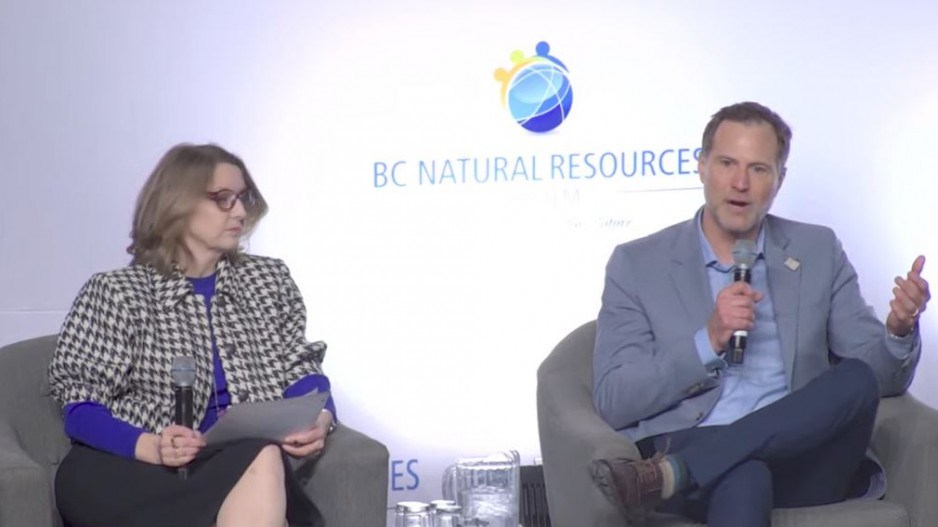Exports from B.C. more than doubled in value over the past 10 years, from $31 billion in 2012 to $64 billion in 2022, according to BC Stats, with steelmaking coal being the single most valuable export, followed by wood products, natural gas, minerals and metals, agricultural products, and pulp and paper, in that order.
Asked at a panel on exports at the BC Natural Resources Forum Wednesday if liquefied natural gas (LNG) produced in B.C. might lead natural gas to become B.C.’s single most valuable export, Bryan Cox, vice president of external affairs for Petronas, answered unambiguously: “Yes.”
“This is a responsible growth opportunity that comes with great opportunities to abate carbon and that investment drives innovation,” he added.
LNG isn’t the only valuable export that comes from natural gas production, however, and there are other forms of energy with commercial potential that may be either derived from, or replace, natural gas.
One of those exports is propane, which is one of the liquids – along with light oil and condensate – produced in northeastern B.C.’s liquids-rich Montney formation. New propane export terminals in Prince Rupert have lead B.C. to quietly become a major propane exporter.
“B.C. is the largest producer of Canadian propane,” Shannon Watt, CEO of the Canadian Propane Association, said at a panel discussion on sustainable energy solutions. “We already export 100,000 barrels of propane to Asian markets.”
While propane and natural gas are fossil fuels, they are lower in carbon intensity than other fossil fuels, such as coal, and the natural gas produced in B.C. has a comparatively low emissions intensity, partly due to electrification of the upstream, as well as its lower methane emissions. (A study by St. Francis Xavier University in 2021 concluded methane emissions from gas wells in Montney formation of B.C. were “amongst the lowest in North America.”)
Sometime next year, B.C. will become Canada’s biggest – indeed only – exporter of liquefied natural gas.
“I'm representing a project that is now 90 per cent complete,” said Teresa Waddington, vice president of corporate relations for LNG Canada. “We are 90 per cent complete to bringing Canada’s first LNG export facility to life.”
While natural gas will be used for the chilling process, the rest of the LNG Canada plant in Kitimat will be powered with clean hydro electricity, which helps to reduce the emissions intensity of the LNG it will produce.
“Our project represents an LNG facility that produces LNG at the one of the lowest greenhouse gas (intensities) in the world today,” Waddington said.
Other LNG projects in the works – Cedar LNG, Woodfibre LNG and Ksi Lisims – will have even lower emissions intensities, as they will use electric drive for the chilling process.
Waddington said she was proud to see LNG Canada help lay the groundwork for some of those other LNG projects.
“We desperately need all of them,” she said. “There is room for every single one of those and then some.”
Hydrogen is another energy source that could eventually be produced in and exported from B.C. It can be made either from water and electricity or from natural gas.
While there may be export opportunities for hydrogen at some future date, there are also potential domestic uses. One is blending hydrogen into the current natural gas stream to reduce its carbon emissions intensity.
One of the projects Enbridge (TSX:ENB) is currently working on in B.C. is the testing of its pipelines for carrying hydrogen.
“We're working with FortisBC and the ministry of Energy, Mines and Low carbon Innovation… to examine how we can transport and distribute hydrogen on our existing gas systems to help reduce greenhouse gas emissions,” said Cynthia Hansen, president of gas and midstream for Enbridge.
“So that study is going to look at the percentage of hydrogen that can be safely transported in our existing systems, and the results of this study will be used to help develop regulatory standards and inform the development of the commercial hydrogen market in B.C.”
Doug Slater, vice president of external and indigenous relations for FortisBC – B.C.’s largest natural gas utility -- said hydrogen could prove a valuable “bridge” between natural gas and electricity, especially in energy storage to deal with seasonal peaks, like the one B.C. just witnessed with a cold snap that placed huge demands on both the natural gas and power grids.
“When we look into the future, we see hydrogen as a bridge on the fuel end,” Slater said. “It can be produced at times when there's excess electricity, and it can be consumed and turned back into electricity at times were needed.”
But it is renewable natural gas that presents the biggest opportunity for FortisBC, he said, when it comes to sustainable fuels and energy.
“For our utility, renewable natural gas is the greatest near-term opportunity that we see,” Slater said. “We have about 10 per cent of our supply under contract, which occurred largely over the past four or five years.
“So it can come on quickly. There's a lot of projects under development. And we see that as forming a huge part of the near term. It blends so our customers don't have to really change anything in their households.”






